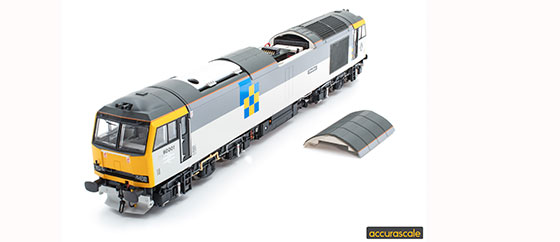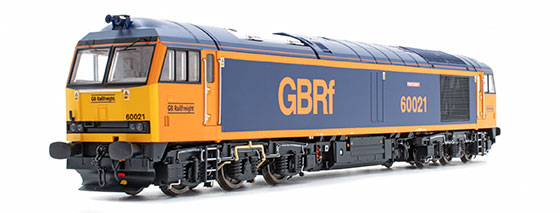07 June 2024
|
Accurascale’s Class 60 signals the return to the products of Loughborough and take on its biggest and most powerful production diesel locomotives.
Development work on this new model began almost three years ago as a locomotive model compatible with its modern air-braked wagon offerings. The "Tugs" complement Accuracale’s later members of its "Powering Britain" coal wagons, biomass wagons and of course the aggregate and steel wagons, too.
Despite the Class 60 looking pretty much the same as it did when the first one rolled out of BEM Traction Division in Loughborough all those years ago, they have received plenty of subtle modifications and changes over their careers in front line service. It is Accurascale’s mission to correctly capture these and bring modellers the most extensively researched Class 60 on the market. This included invaluable cooperation with the staff of UKRL Loughborough, including team members who were originally involved with the initial commissioning and building of the locos. DB Cargo and DC Rail have also contributed massively to Accurascale’s model.

Elements such as the original twin exit exhaust silencer and replacement single exit alternative, the roof panel without vents or scavenger fans, differing lamp brackets depending on locomotives (which will be yellow, not black on the models), two-piece windows on the driver's side and updated three piece replacements, early fibreglass snow plough and their steel replacements, T piece metal plates in the radiator room to prevent the locos being counted as a wagon on MGR trains by scanners, air receiver in original and modified positions, extended long range and standard fuel tanks, exposed and covered buffer beams, radio aerial brackets, air ventilation scoops on the cab fronts, modified multiple working socket covers, original and modern LED style lighting clusters and more.
Standard specification includes; full lighting package of independently controlled head, tail, marker lights and bi colour LEDS where relevant with various day, night and depot configurations, cab lights, control desk light, radiator room lighting, magnetic roof hatch to access your DCC decoder and DC light mode switches, helical gearing, space for EM and P4 wheels with drop in replacement wheels available separately, hall sensor to automatically detect curves and activate flange squeal on DCC sound locos, stay alive capacitor bank for uninterrupted running, large Accurathrash speaker set up with ESU Loksound 5, and a weighty die-cast chassis (over 800g!) with all axle drive to move those miniature mountains.

Accurascale has received and signed off with feedback on the decorated samples and the purchase order is now with the factory. That means quantities are set and the 60 is production-approved, so availability will be strictly limited between direct sales and quantities that manufacturers will receive. Delivery is expected around Q2 2025.
There will be seven different Tugs to choose from in the initial launch range, with another four more exclusive locomotives to come soon between exclusives, a charity fundraiser and a retailer exclusive. Prices begin at £169.99 for the DC/DCC ready versions, and £269.99 for DCC sound fitted variants.

About the prototype
The 1980s saw a requirement for more heavy freight locomotives to deal with a growth in the heavy haul sector. British Rail’s incumbent fleet of Type 5 locomotives (i.e. those with a rated power of over 3000 hp) consisted of Class 56 and Class 58 - 185 locomotives in total, but more were needed. British Rail drew up a Specification of requirements, and an Invitation to Tender was placed with manufacturers in 1987. Bids were received from Metropolitan-Cammell, GEC and Brush Electrical Machines, Traction Division. After an extended tender evaluation period, the 100 locomotive order was given to Brush, who offered the most specification compliant and cost-effective bid.
The locomotive was to be at the cutting edge of technology and harnessed a 145 litre, 8-cylinder, 3,100 horsepower Mirrlees Blackstone Four Stroke Diesel engine coupled to a Brush alternator providing power to the two, three axle bogies. With one DC traction motor per axle, each was ‘SepEx’ controlled. The ‘Separately Excited’ traction motor control scheme offered an improvement over the basic type of wheel slip “creep control” employed by General Motors, and it gave an advanced form of traction control which operated from standstill which allowed full use of the 500 kN tractive effort of the locomotive in all weathers to maximise the power at the rail.
The Class 60’s were constructed at the Brush Falcon Works in Loughborough between 1989 and 1991. Although all the design work was conducted by Brush, the bodyshell fabrication was subcontracted Procor of Wakefield to a monocoque load bearing design which alleviated the need for a deep section underframe type chassis like the imported Class 59s. These bodyshells were delivered to Brush by road fully painted and were set on stands in the Erecting Shop where they were met by the other major components such as the Power Unit from Mirrlees in Stockport, Cooler Group from Serck, and the bogies which were built at in a separate facility within Brush Works.
The first locomotive was completed for the formal handing over ceremony on the 30th of June 1989 just 13 months after the contract was awarded. Representatives from British Railways Board, Trainload Freight, Brush and various invited guests descended on Loughborough for the naming before 60001 ‘Steadfast’ was delivered to Toton TMD under its own power. It was then moved on to the Railway Technical Centre in Derby for instrumentation fitment, testing and analysis. Once the locomotives began to operate in traffic, it was clear that the haulage capacity of the Class 60 was beyond expectations, and it then set a new standard for heavy freight haulage capacity across the Country.
In 1994, the trainload freight business was broken up into three shadow franchises, Loadhaul, Mainline and Transrail. The Loadhaul allocated machines received a distinct modification to the others and were fitted with an additional fuel tank of 200 gallons, this was sited between the compressors underneath the locomotive. The additional tank displaced an air tank which was re-sited in the radiator room and is visible through the large side grille.
Unfortunately, the shadow franchise’s colourful liveries only lasted 2 years, as the three Companies were purchased in 1995 by ‘North South Railways’, a company parented by Wisconsin Central in the USA. This name however did not stay for long, and EW&S was unveiled to the press in 1996. Now around 6 years old, all 100 locomotives passed to the new freight operator. The fleet was ageing gradually and coming up for BR style maintenance & overhaul requirement when some locomotives began to suffer unusual engine failures on some high hours engines. As a result of analysis, EWS began to sideline locomotives coming up for costly high hours/high mileage maintenance Exams. As a result of this, EWS took the decision to place numerous locomotives in store based on their accumulated engine hours.
DB Schenker arrived on the scene in 2008, taking over from EWS and as such, inheriting the dwindling class 60 fleet. Their assessment of the class held them in much higher regard. Overhaul plans were dusted off in 2011 and DB Schenker announcing a program to not just overhaul but upgrade seven class 60’s with a view that further members would be upgraded at a later date if successful. This was the launch of the ‘Super 60’ program.
The Super 60 was essentially a heavy works overhaul with a series of upgrades processed at the same time. It is notable that no class 60’s had received this level of works visit at 20 years old when comparable Type 5 locomotives would have been through the works several times! Two locomotives were trialled first, 60011 received an electrical overhaul/upgrade and 60099 had a mechanical overhaul/upgrade. The results of this gave DBS the confidence to press on with the first Super 60 being 60007, and to date over 20 locomotives have been through the program for DBS / DB Cargo, and they have continued to provide power for the trains for which they were built.
During 2010, DBS had offered various locomotives for sale without success. However, a later deal between DB Schenker and Colas Rail in 2014 led to the acquisition of 10 locomotives which were to be put through the ‘Super 60’ programme. 60087 became the first Colas 60 to be released to traffic in May 2014. The Colas 10 were short-lived as an additional order for General Electric class 70s led to the class 60’s being sold to GB Railfreight in 2018. Several other Class 60’s had also been offered for sale by DBS, some failed to attract reserve bids, and some were sold to metal recyclers which sadly led to 60006 being the first member of the class to be scrapped. Fortunately, some of those sold for scrap have since been ‘preserved’, but yet to be made serviceable. Further sales in 2019 led to DCR buying four locomotives and having them overhauled by DB Cargo. These entered service in late 2019. The success of these four locomotives led DCR to buy a further 15 locomotives in 2022 to cover future fleet expansion requirements.
Your weekly World of Railways newsletter
Are you subscribed to our weekly email newsletter? Don't miss the latest news, reviews, modelling advice and competitions.

